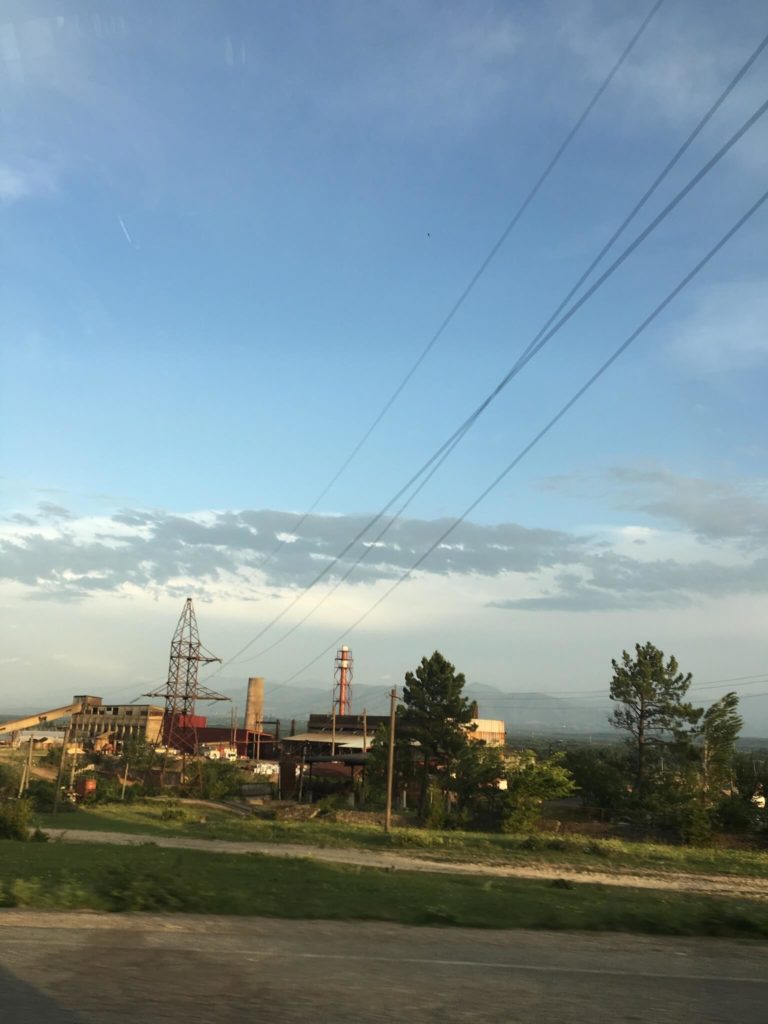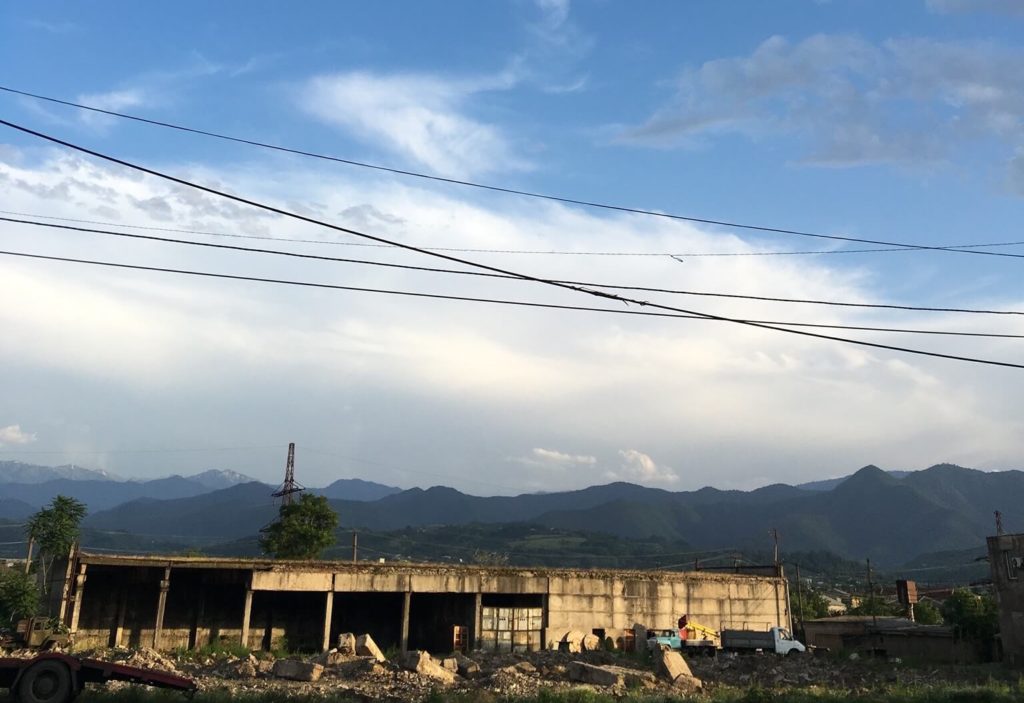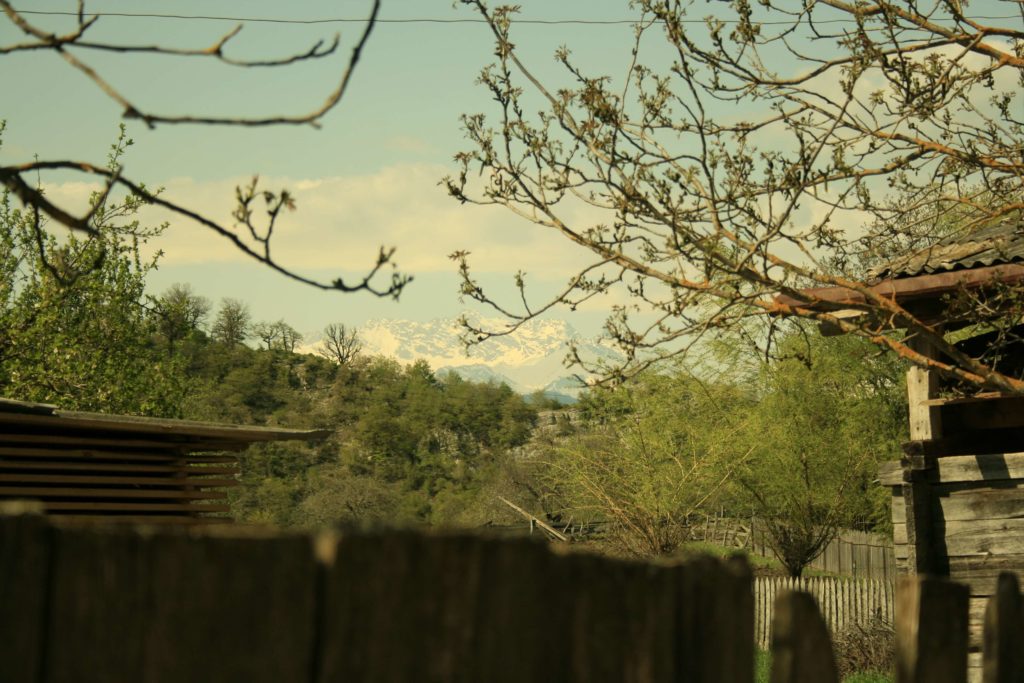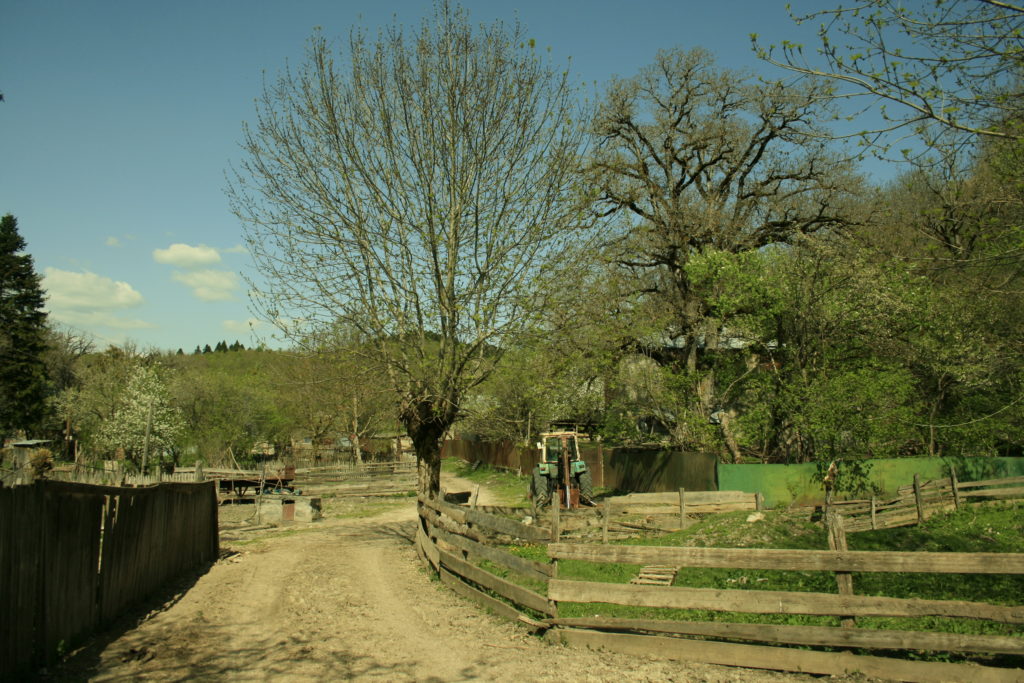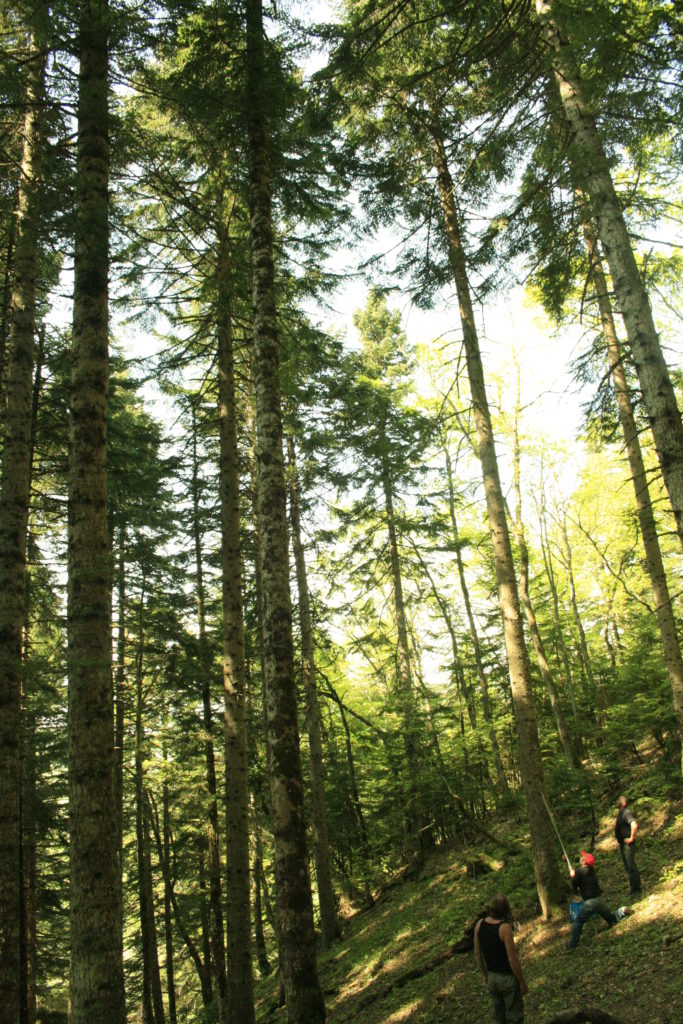Emptiness, ghost towns and social afterlives
DOI: 10.60650/EMPTINESS-82CN-JQ21
Along Route S1, flowing through Georgia from Tbilisi to the Black Sea coast, the surrounding landscape bears witness to the environmental diversity of the country and people’s dependence on it. Lush forest interchanges with river beds, mountains and valleys; locals sell homemade or homegrown goods and produce by most villages along the route. But the route also bears witness to the grand projects of Soviet modernity that attempted to conquer nature. Their traces reveal themselves as partly or completely abandoned industrial areas or cities.
The mining city of Chiatura is a case in point. Until the late 18th century, when manganese and peroxide were discovered in the area, Chiatura was merely a mountain village. The first mine was established in 1872. Only a few decades later, Chiatura was home to one of the world’s largest manganese mines which met half of the demands of the world market. As Georgia became part of the Soviet Union in 1921, mining was expanded not just in Chiatura but all over Georgia, with a range of cities becoming hubs of heavy industry. Workers from across the Soviet Union were brought to these places by the thousand and villages slowly morphed into industrial landscapes. As in other Soviet industry towns, urban infrastructure grew around the industry. Apartment buildings were erected to house workers, accompanied by shops and public institutions, such as kindergartens and cinemas.
Large parts of the industrial sector collapsed in the wake of the dissolution of the Soviet Union in 1991. Numerous families suddenly lost their livelihoods, and their future prospects were dire. Chiatura and other industrial cities slowly depopulated and fell into decay. Today, three decades after the collapse, emptiness has become the predominant mark of the landscape: rusty cranes, unused electricity pylons, abandoned factory halls, and overgrown train tracks.
The postindustrial areas along Route S1 in Georgia are ghost towns par excellence – they have been abandoned but have not disappeared.
The postindustrial areas along Route S1 in Georgia are ghost towns par excellence – they have been abandoned but have not disappeared. The empty houses and factories are haunting presences that force the remaining residents to keep asking themselves how it could go so wrong, and why life has not restarted. They are also classic examples of specifically post-Soviet ghost towns that emerged around an industry based on natural resource extraction which collapsed with the collapse of the Soviet Union itself.
However, there are other towns in Georgia, ones where industry and business based on natural resources continue but which are slowly – and seemingly paradoxically – turning into ghost towns.
Tlugi
If you turn off Route S1 and continue north along smaller roads towards the Russian border, you arrive in the Racha-Lechkhumi province and find a similar situation. Here it was lead, arsenic and zinc rather than manganese that was extracted from the underground during the Soviet period. Due to the sudden discontinuation of the mines and the length of time that passed before anyone showed interest in re-establishing extraction, most factories and plants are now either too expensive to repair or have become sites of pollution – for example, by arsenic surfacing from underground. Thus here, too, completely or partially abandoned villages and cities are part of the landscape. Tlugi is one of them.
But other factors have contributed to the emptying of Tlugi. Large parts of the village were destroyed during an earthquake in 1991 that affected a total of 700 villages in the region and left over 100.000 people homeless. In Tlugi, as well as in larger cities in Racha-Lechkhumi, several collapsed houses testify that some people did not rebuild their homes after the earthquake, but instead chose to move to the capital or emigrated abroad. The villages’ location near the Russian border meant that in the wake of the Russo-Georgian war in 2008, there was a sharp decline in the number of tourists who otherwise had slowly begun to take an interest in the area. Moreover, Tlugi’s location in a mountain area means that it is difficult to access even for locals. The small gravel roads are blocked by snow during winter; after prolonged periods of rain they often wash away completely. The villagers therefore have to be prepared for the fact that they cannot always leave the village during winter unless it is on foot. Lack of schooling and shopping opportunities means that fewer and fewer families are willing to stay.
Paata is one of the only remaining year-round inhabitants of Tlugi. I met him during my first fieldwork in the region in 2013. He agreed to show me around the village even though, as he noted, “there is no longer much to see”. Paata is a carpenter and has built his own house from scratch. Sometimes he succeeds in finding work locally when other houses in the area need restoration. It’s very rare, however, he explains, that the houses are restored for permanent living. Rather, it is most often because former residents want to maintain a relationship with the area and therefore rebuild their houses into cottages or dachas. But even those who do, he continues, almost never come to visit. An international humanitarian organization donated a tractor to the village a few years ago so that locals could plow the small terraced fields that surround the village in order to increase the possibility of self-sufficiency. But as Paata explains, it is now rarely used. There is simply no one here to use it. With a handful of families living in the village, Tlugi is not yet fully a ghost town, but it is slowly being abandoned.
The forest
Although Tlugi has much in common with the completely or partially abandoned towns along Route S1, there is one thing that makes it stand out. The village is located near a natural resource that has also formed, and still does, the basis of a massive industry which nevertheless has received much less attention: pine cones. Not far from Tlugi is an extensive forest area that consists almost exclusively of Nordmann fir. The seeds from the 30-40 meter-tall trees are the basis for over 80% of all Christmas trees sold in Europe. For decades, cones and seeds have been bought by primarily German and Danish companies who then grow and sell the trees in Northern Europe. The forest around Tlugi is one of the only places in the world where the Nordmann fir grows naturally and grows old enough for the cones and seeds to have the right quality. The forest is state owned and divided into sectors that through auctions are licensed out to companies who buy the rights to pick a defined number of cones annually, measured in tons. At lot of money is at stake in this industry, and cone-picking is now one of the only opportunities for work for the remaining inhabitants.
Paata is also a cone-picker. And even though harvest is only possible once a year, during a few weeks in late summer, it is an important source of income for him. The cones can only be harvested manually, and it is a risky job to climb all the way up into the canopy where the cones are located. He has received special training in climbing and wears safety equipment while doing so. He does so because the company he works for requires it, but not all companies take such precautions. On the contrary.
Every year there are workers who plunge to their deaths in an attempt to reach the top of the trees, and it is not just adults but also children who put themselves at this risk. One of them is Gio. He lives with his mother and should ideally be spending all his time going to school. But since his father died, he has had to take occasional work to support the household. As he is only 13, he cannot participate in the organized cone picking. But that does not mean he doesn’t pick cones during harvest season as the organized picking only forms a small part of harvesting that takes place. A large number of middlemen buy cones from people like Gio who, without licenses and safety equipment, climb up the trees and harvest cones illegally at nighttime.
The cones are branded when they are sold on to German or Danish buyers, which erases their illegal origins. Many tons of illegally harvested, but subsequently legalized, cones and seeds are shipped to Northern Europe every year, where they are grown into thousands upon thousands of Christmas trees. The price the local pickers get for these cones is far below the standard, but since there are rarely other ways to find an income many turn to it as a last resort despite the low price and the dangers it entails. Gio knows the risk – his father died doing the same job. The shift in extractive industry from lead and zinc to pinecones is perhaps at first glance one that carries positive overtones when considering the dangers of working in mines and the potentials for pollution inherent to them. But it has also led to a shift from a type of extraction accompanied by modernization and the building of infrastructure, to a type of extraction where an individual’s body is at once crucial to the extraction process and entirely disposable.
Social afterlives
In Tlugi, it is not only the creeping material emptiness that surrounds the place – it is equally the social ghosts that gradually make locals abandon the village. A social ghost or afterlife is, in an anthropological perspective, not a question of souls continuing to linger, but of material or social structures that somehow remain stuck even though they are in principle gone. This can be, for example, in the form of abandoned and empty houses, factories and institutions; it can be traces of neighbours and friends who suddenly decided to move away, or fences without cattle and fields that are no longer being cultivated. Or it may be in the form of memories of the Soviet era, of former industry, of earthquakes, of war, of family members who lost their lives as cone pickers – all of which are part of everyday life for the few remaining inhabitants in the region.
Although Paata is not happy with the situation, he has gradually come to terms with it and made a decision to stay. For young people like Gio the situation is different. He has no hopes that it will be possible to create a life in the region, neither through the cone picking industry nor anything else. Although there are companies that ensure cone picking is done safely and also provide a decent salary, there is no guarantee you can get a job with them. And the season is too short to earn money for a whole year. Like most of his peers, Gio’s greatest hope therefore centers on only one thing: getting away. The aging population in the region also testifies to the fact that many young people have already left, either to obtain an education or to find work. In that sense, they, too, become part of the memory of a place that was once a village.
(Parts of this text was previously published in Danish in Geografisk Orientering.)
This is an Open Access article, distributed under the terms of the CC-BY (Creative Commons Attribution 4.0 International) licence, which permits unrestricted re-use, distribution, and reproduction in any medium, provided the original work is properly cited.
